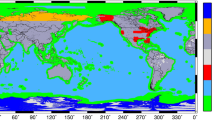Abstract.
Based on the analysis of various factors controlling isostatic gravity anomalies and geoid undulations, it is concluded that it is essential to model the lithospheric density structure as accurately as possible. Otherwise, if computed in the ‘classical’ way (i.e. based on the surface topography and the simple Airy compensation scheme), isostatic anomalies mostly reflect differences of the real lithosphere structure from the simplified compensation model, and not necessarily the deviations from isostatic equilibrium. Starting with global gravity, topography and crustal density models, isostatic gravity anomalies and geoid undulations have been determined. The initial crust and upper-mantle density structure has been corrected in a least squares adjustment using gravity. To model the long-wavelength (>2000 km) features in the gravity field, the isostatic condition (i.e. equal mass for all columns above the compensation level) is applied in the adjustment to uncover the signals from the deep-Earth interior, including dynamic deformations of the Earth’s surface. The isostatic gravity anomalies and geoid undulations, rather than the observed fields, then represent the signals from mantle convection and deep density inhomogeneities including remnants of subducted slabs. The long-wavelength non-isostatic (i.e. the dynamic) topography was estimated to range from –0.4 to 0.5 km. For shorter wavelengths (<2000 km), the isostatic condition is not applied in the adjustment in order to obtain the non-isostatic topography due to regional deviations from classical Airy isostasy. The maximum deviations from Airy isostasy (−1.5 to 1 km) occur at currently active plate boundaries. As another result, a new global model of the lithosphere density distribution is generated. The most pronounced negative density anomalies in the upper mantle are found near large plume provinces, such as Iceland and East Africa, and in the vicinity of the mid-ocean ridge axes. Positive density anomalies in the upper mantle under the continents are not correlated with the cold and thick lithosphere of cratons, indicating a compensation mechanism due to thermal and compositional density.
Similar content being viewed by others
Acknowledgments.
Thoughtful reviews by one anonymous reviewer, L.E. Sjöberg and B.L.A. Vermeersen improved the text greatly.
Author information
Authors and Affiliations
Corresponding author
Rights and permissions
About this article
Cite this article
Kaban, M., Schwintzer, P. & Reigber, C. A new isostatic model of the lithosphere and gravity field. Journal of Geodesy 78, 368–385 (2004). https://doi.org/10.1007/s00190-004-0401-6
Received:
Accepted:
Published:
Issue Date:
DOI: https://doi.org/10.1007/s00190-004-0401-6




